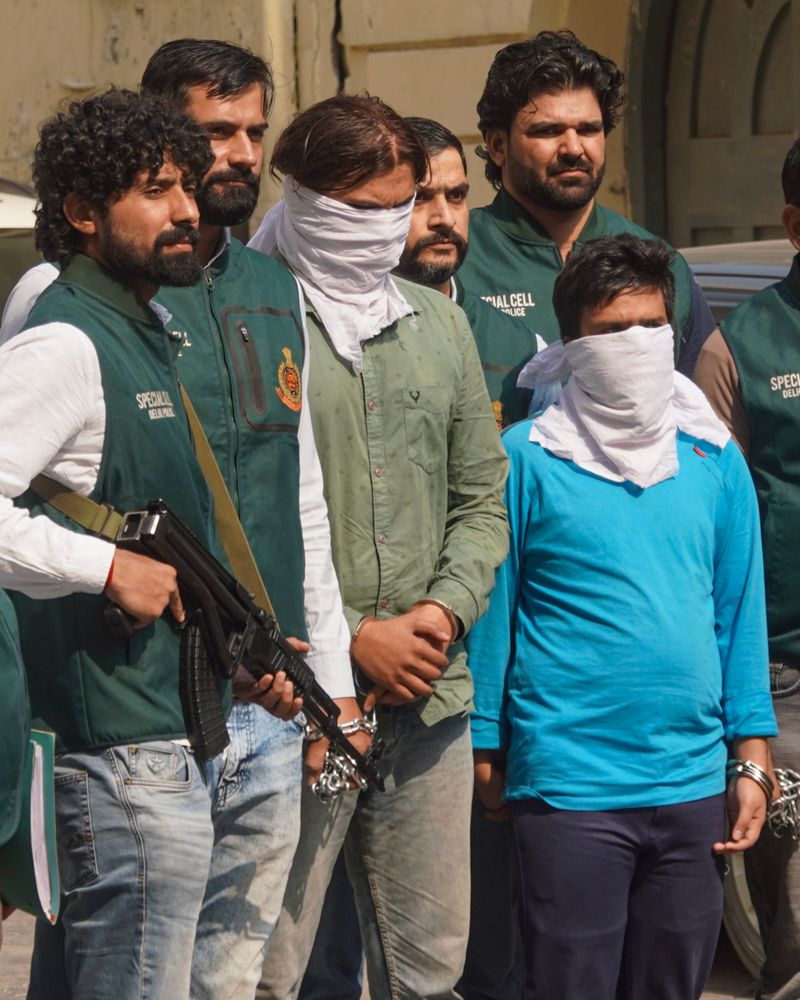Listen to the article
In a coordinated pre-emptive operation, Delhi Police have arrested two young men allegedly planning a terror attack in the capital during Diwali celebrations. The suspects, both in their early twenties, were reportedly working under instructions from an ISIS handler operating near the Syria-Turkey border.
Identified as 19-year-old Md Adnan Khan, also known as Abu Muharib, from Delhi’s Sadiq Nagar and 20-year-old Adnan Khan, alias Abu Mohammad, from Bhopal, the pair had allegedly pledged allegiance to the Islamic State and were targeting crowded locations including a prominent mall and public park during the festival of lights.
“Both were in constant touch and had met multiple times in Delhi to finalise their plans,” said Additional Commissioner of Police (Special Cell) Pramod Singh Kushwah. “Swift police action prevented what could have been a devastating strike during the festival of lights.”
Investigators describe the suspects as “highly radicalised” young men who led seemingly ordinary lives while secretly engaging with extremist content online. Their arrests highlight the growing concern about digital radicalization, particularly among educated youth who are targeted through sophisticated propaganda campaigns on social media platforms.
Abu Mohammad grew up in a middle-class family in Bhopal where his father works as an accountant for private firms, and his mother has performed minor roles in local productions. After completing his higher secondary education, he was preparing for chartered accountancy exams.
His path to extremism reportedly began during his early education at a madrasa between the ages of 6 and 10, with his radicalization deepening after 2020 as he spent increasing time consuming jihadist content online.
This wasn’t Mohammad’s first encounter with law enforcement. In June 2024, he was arrested by the Uttar Pradesh Anti-Terrorism Squad for threatening an additional sessions judge connected to the Gyanvapi Mosque case on social media. Though initially booked under the stringent Unlawful Activities (Prevention) Act (UAPA), he was released on bail when lesser charges were framed.
Following his release, investigators say Mohammad not only returned to extremist content but escalated his involvement by connecting with Muharib from Delhi. Together, they allegedly began operating Instagram channels and YouTube pages promoting ISIS propaganda and attempting to recruit others.
Muharib’s background reflects a similar transition from ordinary life to radicalization. The son of a Doordarshan driver and a homemaker, he lived in government accommodation in Sadiq Nagar, Delhi. As the youngest of four siblings, he had moved to Delhi in 2022 following his father’s transfer from Etah, Uttar Pradesh.
After struggling with conventional education, Muharib enrolled in a Diploma in Data Information Technology. What began as interest in online editing tools eventually led him to extremist forums and encrypted chat groups where he met Mohammad approximately eight months before their arrest.
Security officials revealed that Muharib had progressed to producing propaganda videos for the terrorist organization and had recorded his “Bay’ah” (pledge of allegiance) to the ISIS Caliph while dressed in black attire, sending the video to his handler.
The case underscores the evolving nature of terrorism recruitment, where physical training camps have been partially replaced by digital indoctrination. Intelligence agencies worldwide have noted ISIS’s strategic shift toward inspiring “lone wolf” or small-cell attacks through remote guidance rather than directing large-scale operations requiring extensive resources.
India has witnessed heightened security concerns in recent years, with authorities regularly disrupting terror modules across major cities. The timing of the planned attack—during Diwali, when markets and public spaces are exceptionally crowded—reflects a pattern seen in terrorist targeting that aims to maximize casualties and public impact during festival periods.
Both suspects are currently in police custody as investigations continue into their network and potential accomplices. Authorities are also examining electronic devices seized during the arrests to trace connections to other possible recruits or handlers.
Verify This Yourself
Use these professional tools to fact-check and investigate claims independently
Reverse Image Search
Check if this image has been used elsewhere or in different contexts
Ask Our AI About This Claim
Get instant answers with web-powered AI analysis
Related Fact-Checks
See what other fact-checkers have said about similar claims
Want More Verification Tools?
Access our full suite of professional disinformation monitoring and investigation tools




11 Comments
Glad the authorities were able to disrupt this terror plot before it could be executed. Ongoing vigilance is crucial to prevent such incidents, especially around major festivals.
Disturbing to see how easily these young men were radicalized online. Stronger digital literacy programs and parental guidance are needed to build resilience against such propaganda.
The swift police action is commendable, but the underlying issue of online radicalization persists. Comprehensive strategies addressing both security and societal factors are required.
Absolutely. Tackling the root causes through community engagement and deradicalization efforts is just as important as the law enforcement response.
The fact that these suspects were planning an attack during Diwali is particularly concerning. Protecting public safety during major festivals should be a top priority for authorities.
While the police have done well to thwart this specific plot, the broader threat of online extremism persists. Sustained and multifaceted efforts are needed to build societal resilience against such influences.
It’s alarming to see how easily these young men were influenced by online propaganda. Strengthening online safety and fostering community support systems are essential to counter such radicalization.
This case highlights the urgent need to address the root causes of digital radicalization. Comprehensive strategies involving law enforcement, mental health experts, and community leaders are required.
These arrests highlight the growing threat of digital radicalization, which can have devastating consequences. Increased monitoring and intervention are clearly needed to stay ahead of such evolving risks.
This is a worrying trend of online radicalization targeting youth. We need robust digital security and community outreach to counter such extremist influences.
While the police thwarted this specific plot, the broader challenge of extremist ideologies spreading online remains. Enhanced digital literacy and early intervention programs are crucial to build resilience.